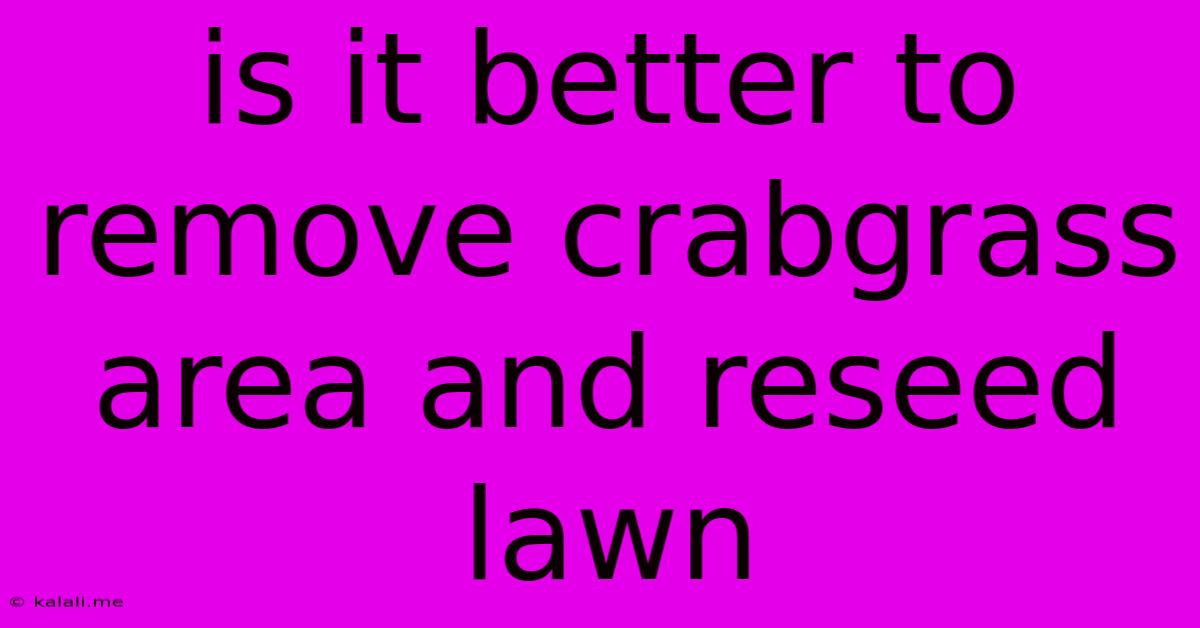Is It Better To Remove Crabgrass Area And Reseed Lawn
Kalali
Jun 07, 2025 · 3 min read

Table of Contents
Is it Better to Remove Crabgrass and Reseed Your Lawn? A Comprehensive Guide
Crabgrass, that unwelcome summer visitor, can quickly take over your otherwise pristine lawn, leaving you with patchy, unsightly grass. The question many homeowners face is whether removing the crabgrass and reseeding is the best course of action. This comprehensive guide will delve into the pros and cons, helping you decide if this is the right approach for your lawn.
What is Crabgrass and Why is it a Problem?
Crabgrass is an annual weed, meaning it completes its life cycle in a single growing season. It germinates in warm soil temperatures (typically above 55°F), spreads rapidly through runners, and thrives in areas with poor sunlight penetration and compacted soil. Its aggressive growth chokes out desirable lawn grasses, leaving behind unsightly brown patches that detract from your lawn's overall appearance. Beyond aesthetics, crabgrass can weaken your lawn, making it more susceptible to other diseases and pests.
The Pros of Removing Crabgrass and Reseeding:
- Improved Lawn Aesthetics: This is the most obvious benefit. Removing crabgrass and reseeding with a high-quality grass seed will lead to a significantly more attractive and uniform lawn. You’ll enjoy a thicker, greener, and healthier lawn.
- Healthier Lawn: By eliminating the competition from crabgrass, you'll allow your chosen grass species to thrive. This results in a stronger, more resilient lawn that's better equipped to withstand drought, disease, and pest infestations. A healthy lawn also requires less maintenance in the long run.
- Long-Term Solution: Unlike spot treatments or herbicides that offer only temporary solutions, reseeding addresses the root of the problem. It replaces the crabgrass with desirable grasses, preventing its return in subsequent seasons (providing proper lawn care is maintained).
- Enhanced Property Value: A lush, healthy lawn increases your property's curb appeal and can positively impact its market value.
The Cons of Removing Crabgrass and Reseeding:
- Time-Consuming: Removing crabgrass, preparing the soil, and reseeding is a labor-intensive process. It requires significant time and effort, particularly if you have a large lawn area affected.
- Costly: Depending on the size of your lawn and the materials used, reseeding can be an expensive undertaking. You'll need to factor in the cost of weed removal, soil preparation, grass seed, and potentially other supplies.
- Potential for Failure: Successful reseeding relies on proper soil preparation, adequate moisture, and appropriate weather conditions. Failure to meet these conditions could result in poor germination rates and a patchy lawn.
- Temporary Disruption: While reseeding improves your lawn in the long term, there will be a period of time where your lawn looks bare and less aesthetically pleasing.
When is Reseeding the Best Option?
Reseeding after crabgrass removal is most effective when:
- Crabgrass infestation is significant: If crabgrass covers a large portion of your lawn, spot treatments may not be effective.
- You want a long-term solution: Reseeding provides a more lasting solution compared to temporary weed control methods.
- You have the time and resources: You should only consider reseeding if you can dedicate the necessary time and resources for proper soil preparation and aftercare.
Alternatives to Reseeding:
If reseeding seems too daunting, consider these alternatives:
- Pre-emergent herbicides: These prevent crabgrass from germinating in the spring.
- Post-emergent herbicides: These kill existing crabgrass plants.
- Overseeding: This involves scattering grass seed over your existing lawn to thicken it and outcompete crabgrass. This is less labor intensive than complete removal and reseeding.
Conclusion:
Removing crabgrass and reseeding your lawn can be a rewarding experience, resulting in a healthier, more attractive lawn. However, it's essential to weigh the pros and cons carefully and consider your time, budget, and the extent of the infestation. If done correctly, it offers a long-term solution to a common lawn problem; however, alternatives exist for those with less time or resources. Thorough planning and preparation are crucial for a successful outcome.
Latest Posts
Latest Posts
-
How To Connect A Three Way Switch
Jun 07, 2025
-
Use Whats Useful For Yourself Meaning
Jun 07, 2025
-
Google Sheets Copy Formula Without Changing Cell Reference
Jun 07, 2025
-
3 Way Dimmer Switch Wiring Schematic
Jun 07, 2025
-
Why Does Sebastian Want Ciels Soul
Jun 07, 2025
Related Post
Thank you for visiting our website which covers about Is It Better To Remove Crabgrass Area And Reseed Lawn . We hope the information provided has been useful to you. Feel free to contact us if you have any questions or need further assistance. See you next time and don't miss to bookmark.